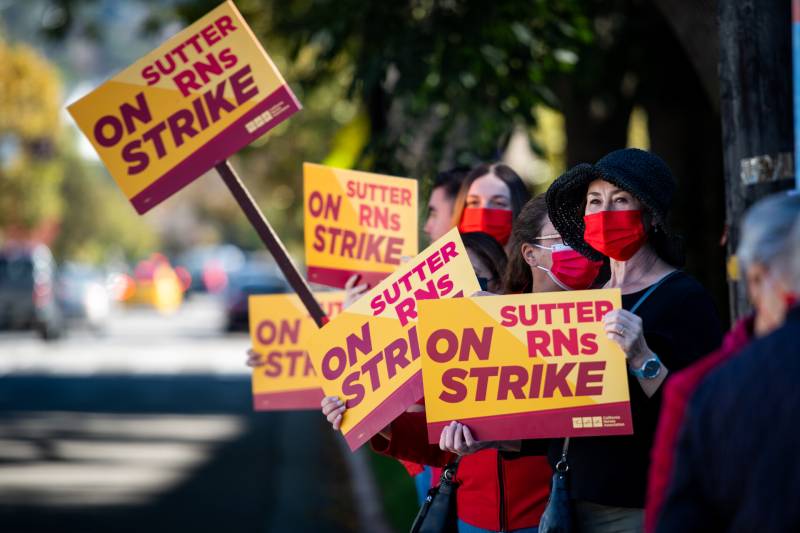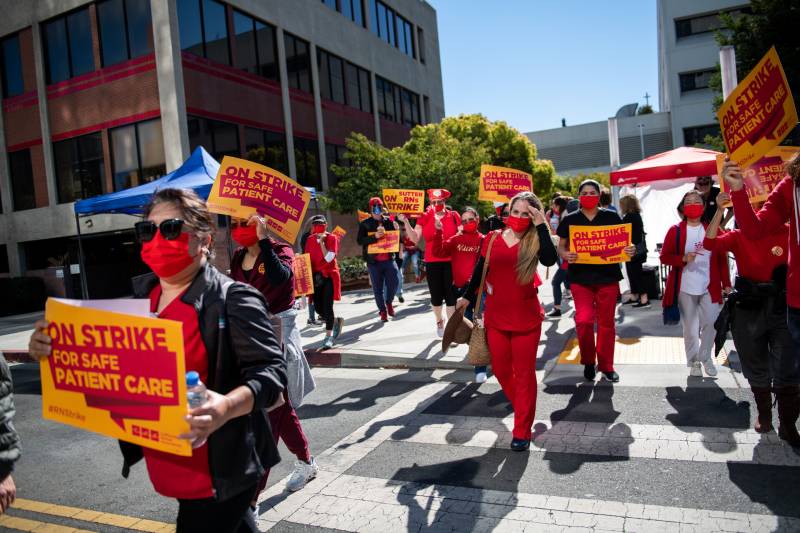Nearly 2,000 registered nurses at Alta Bates Summit Medical Center campuses in Oakland and Berkeley began a five-day strike Monday in response to high turnover rates, staff shortages and workplace safety issues.
The nurses, represented by the California Nurses Association and National Nurses United, called on Sutter Health to implement workplace violence prevention plans, increase staffing and provide more robust safety resources, including better access to medical-grade safety equipment.
“I am seeing nurses leave the medical center for other nursing positions on a regular basis. We have nurses working overtime, and even double shifts, day after day to keep the hospital running,” said Mike Hill, a nurse in Sutter’s intensive care unit.
Hill said that while workplace violence in hospitals — mostly of patients toward staff — has always been a concern, there was an uptick in incidents during the pandemic, when many patients didn’t have the family support they needed.
“Sometimes it’s intentional. Other times, it’s from anger, fear or a medical condition that causes them to lash out at staff. Either way, it’s dangerous for us as professionals,” said Hill. “It’s not just physical violence. Sometimes it’s verbal threats.”
When workplace violence occurs, hospitals announce “code gray” on the intercom system to alert security, Hill said. But like the nursing team, the security department at Alta Bates is understaffed, and in some cases it takes too long for guards to arrive at the scene, Hill said, forcing other nurses to step in to help their colleagues. Hill said more security guards are needed both inside the hospital and in the parking garage, to prevent vehicle break-ins, thefts and attacks on staff.
Those concerns about violence, he added, are compounded by the hospital failing to take the necessary measures to effectively protect nurses from COVID exposure and other diseases.
Last year, the California Division of Occupational Safety and Health (Cal/OSHA) fined Sutter Health for violations tied to COVID-related workplace safety issues after an investigation was launched in response to the July 2021 death of an Alta Bates nurse, who contracted the disease.
“Sutter must create working conditions to enhance patient care while also providing a safe work environment that retains nurses,” said Hill.
Ann Gaebler, a registered nurse of over 40 years, said she has never seen Sutter “act this disrespectfully” toward nurses, and it’s causing experienced health care providers to leave.
“Without proper mentorship, we see young nurses suffering the moral injury and the moral distress of having to care for patients without the support they need, and so they leave,” Gaebler said in a statement. “This is not how you grow the next generation of nurses or how to take care of a community. We need Sutter to step up to address our concerns about retention, so we can continue to provide excellent care to our patients.”


